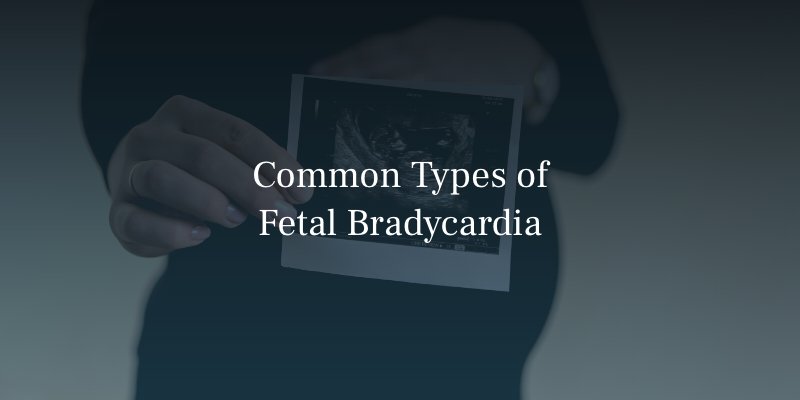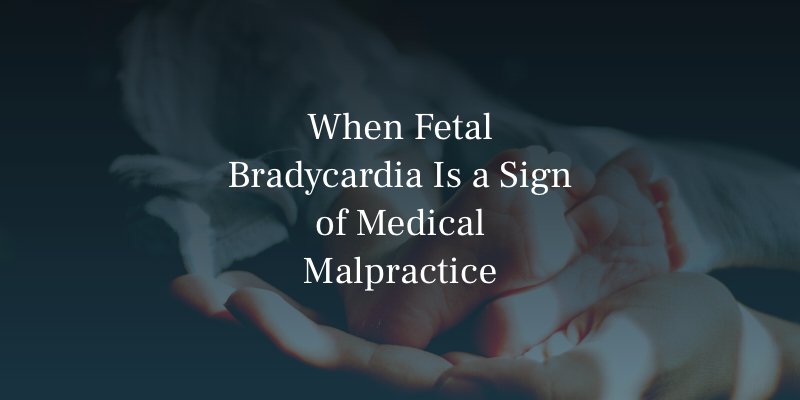When you first see your newborn baby, your heart might “skip a beat”. But no one hopes their baby’s heart actually skips a beat. Abnormal heart rates, like fetal bradycardia, can be dangerous.
If you suspect that medical negligence may have caused your child’s injury, now is the time to act. At Hampton & King, we’ve spent decades fighting for families like yours and holding careless medical providers accountable.
Call (713) 352-7214 or fill out our online form to schedule a free consultation with a qualified Houston, Texas birth injury attorney — no pressure, no obligation.
Here’s what you need to know about how fetal bradycardia occurs, as well as complications that arise when doctors fail to treat it.
What Is Fetal Bradycardia?
In simple terms, it’s when an unborn baby’s heart is beating too slowly. It is also known as a low fetal heart rate. Doctors consider a heart rate low if it drops below 110 for longer than 10 minutes or 100 for 5 minutes. These are fetal arrhythmias (as opposed to fetal tachycardia, which is when fetal heart rate stays above 180 BPM).
Sidenote: Premature atrial contractions (PACs) are early heartbeats originating in the atria – the most common form of fetal arrhythmia. Blocked premature atrial contractions are generally benign, but
A normal fetal heart rate is generally between 110-160 beats per minute. Persistent fetal bradycardia is simply when it persists. There are four types of bradycardia:

Common Types of Fetal Bradycardia
Sinus Bradycardia
Fetal sinus bradycardia in an infant is when the child has a slower-than-normal heart rate for a baby, and the rhythm of the heart originates from the sinus node. For babies, this is usually defined as a heart rate lower than the 5th percentile for age. Transient sinus bradycardia occurs when the fetal heart rate drops into the bradycardia range, but then returns to normal.
Atrioventricular (AV) Block – First Degree
A first-degree AV block is a mild heart rhythm issue. It slows down the electrical signals traveling through the heart (from atria to ventricles) but doesn’t stop them. This doesn’t typically need treatment.
Partial Heart Block – Second Degree
When those electrical signals traveling through the heart are intermittently blocked and don’t reach the lower chambers, this is a partial heart block. This heart block causes a dropped (or missed) beat. This is more serious and medical professionals may consider various treatments depending on the details.
Complete Heart Block – Third Degree
When the electrical signals from the heart’s top chambers are fully blocked and can’t reach the lower chambers, this is a complete heart block. This congenital heart block is very serious, as it causes the heart to beat much slower than normal.
The diagnosis of fetal bradycardia doesn’t always indicate a problem. Sometimes it’s a normal variation and resolves by itself. But it can also be a clear sign that something is wrong with the fetus. It could mean the brain isn’t getting enough blood or oxygen.
That’s a dangerous and worrisome situation. Just a few minutes without oxygen can cause permanent damage to a baby’s brain. For this reason, doctors must monitor fetal heart rate during labor and delivery. If it occurs, the next step is to determine what’s causing it.

What Causes a Fetal Bradycardia?
A variety of factors can make a baby’s heart rate slow down, including:
- A reflex triggered by a medical procedure called umbilical cord sampling.
- A problem with the heart’s electrical system (conduction abnormality).
- A reflex triggered by pressure on the baby’s head or the umbilical cord.
- When the mother exercises too much (this can affect her oxygen levels).
- Low oxygen levels due to the baby’s heart pumping weakly.
- When certain receptors in the baby’s blood vessels sense pressure.
But let’s get a little more specific and delve into the common causes.
Common fetal bradycardia causes include:
- Maternal medication. Certain medications, such as beta-blockers, can cross the placenta. They can reach the fetus and affect its heart rate. Epidural anesthesia and certain medications used to induce or augment labor can lead to bradycardia as well.
- Maternal hypotension. A decrease in the mother’s blood pressure can lead to a decrease in blood flow to the placenta.
- Fetal heart failure or abnormalities. Structural heart disease problems like congenital heart defects can cause it as well.
- Fetal infections. Certain infections can affect the fetal heart rate. Examples include cytomegalovirus (CMV) and parvovirus B19.
- Uterine rupture. A ruptured uterus can cause fetal distress and lead to bradycardia in a baby.
- Systemic lupus erythematosus in the mother. This autoimmune disease can slow the fetal heart rate through the development of congenital heart block in the fetus.
- Cord compression. Compression of the umbilical cord can reduce blood flow to the fetus and slow the heartbeat.
- Polyhydramnios or Oligohydramnios. These terms refer to too much or too little amniotic fluid in the womb.
How should doctors manage bradycardia in a baby? That will vary depending on when bradycardia is taking place and how severe it is. Treatment during pregnancy may be different from treatment during labor.
Often, management includes treatment for fetal bradycardia causes. For example, if maternal hypotension is the cause, doctors should work to raise the mother’s blood pressure.
Fetal Distress Complications & Prognosis Of Bradycardia in a Baby
What happens when doctors fail to catch or treat the condition? Distress, complications and injuries can result.
The prognosis for a fetus is much better when doctors act fast to respond to it.
Otherwise, a fetus could suffer a temporary or permanent injury, such as:
- Complete or partial oxygen deprivation
- Stillbirth
- Preterm birth
- Brain damage
- Paralysis
- Long-term developmental delays
- Nerve damage
- Organ damage
- Cerebral palsy
At times, these injuries occur because of a doctor’s negligence.
Here are some ways that might happen:
- Failing to monitor heart rate
- Failing to detect fetal bradycardia causes and treat them.
- A defective monitoring device or improper installation.
- Failing to deliver a baby by C-section when bradycardia shows it’s necessary.
Let’s say a doctor is negligent while handling the condition, leading to complications. The child’s parents could have grounds to file a malpractice lawsuit.
Here’s an example: A monitor detects a severely low fetal heart rate during delivery. The mother has been in labor for over 7 hours. The issue with the baby’s heart rate is severe enough to require an emergency C-section. But the doctor in charge doesn’t order one.
Instead, the birth team attempts to extract the baby with a vacuum. The bradycardia gets worse, so the doctor finally orders a C-section. But it’s too late. The baby is stillborn. The parents file suit against the doctor and birth team for their negligence. The case settles for $1 million.
Long-Term Prognosis and Risks
Not all babies who experience fetal bradycardia will suffer long-term effects. Some make a full recovery with no signs of developmental delay. However, others may face lifelong health conditions, especially if the bradycardia was prolonged or left untreated.
Potential long-term outcomes include:
- Cerebral palsy: A disorder affecting muscle tone and movement, often linked to oxygen deprivation during birth.
- Developmental delay: Delayed milestones in walking, talking, or motor skills may indicate underlying neurological injury.
- Learning disabilities: Some children may have cognitive impairments that become more noticeable in school.
- Seizure disorders: Epilepsy or neonatal seizures may occur in babies with birth-related brain injury.
- Vision or hearing impairments: Brain damage during birth can sometimes affect sensory processing.
The earlier doctors intervene when fetal bradycardia is detected, the better the outcome tends to be. Delayed diagnosis or response – especially during labor – can significantly increase the risk of permanent injury.
The Importance of Monitoring and Follow-Up Care
After a baby is born with a history of bradycardia, pediatricians may recommend early intervention services, frequent checkups, and neurological assessments to ensure developmental progress is on track. Early support can make a meaningful difference in a child’s long-term quality of life.

When Fetal Bradycardia Is a Sign of Medical Malpractice
Fetal bradycardia is a warning sign. When a baby’s heart rate drops dangerously low, it often means they aren’t getting enough oxygen – and every second counts. Doctors and nurses must act quickly to identify the cause and intervene to protect the baby. When they don’t, and harm results, it may be a case of medical malpractice.
If your child suffered a birth injury after their fetal heart rate dropped and wasn’t addressed appropriately, you may have legal grounds to pursue a malpractice claim. To learn more about your rights, contact Hampton & King at (713) 489-0993 or fill out our online form to schedule a free consultation.
What Medical Negligence Looks Like in Fetal Bradycardia Cases
Not every case of fetal bradycardia is preventable. But when healthcare providers fail to meet the standard of care, and their failure causes harm, it may rise to the level of malpractice. Examples include:
- Delayed diagnosis of fetal bradycardia: Failing to monitor the fetal heart rate continuously during labor or ignoring abnormal readings.
- Improper use or placement of fetal monitors: If the monitor isn’t placed correctly, it may give inaccurate readings – or no warning at all.
- Failure to respond to warning signs: When bradycardia persists and doctors don’t order emergency interventions such as a C-section in a timely manner.
- Inappropriate medication use: Certain labor-inducing drugs (like Pitocin) can cause excessive contractions that stress the baby. If bradycardia follows and providers don’t act, that’s a red flag.
- Ignoring maternal risk factors: In high-risk pregnancies, extra monitoring may be needed. Failing to provide it can increase the chance of a missed diagnosis.
Get Legal Help for Fetal Bradycardia Birth Injuries
No parent should have to suffer the heartbreak of losing a child or watching them struggle with a preventable birth injury. When fetal bradycardia is not properly monitored or treated, the consequences can be life-altering, and in some cases, fatal. If medical negligence played a role, you may be entitled to compensation to help cover medical expenses, long-term care, and the emotional toll on your family.
Birth injury lawsuits can also hold negligent providers accountable and help prevent similar tragedies from happening to others. But time is critical. Each state has its own statute of limitations, and waiting too long could jeopardize your right to file a claim.
If you believe your child’s injury was caused by mismanaged fetal bradycardia, contact Hampton & King at (713) 489-0993 or complete our simple online form to schedule your free consultation today.
Fetal Bradycardia FAQs
Bradycardia in a fetus can be caused by several factors, including umbilical cord compression, fetal hypoxia, maternal drug use, congenital heart defects, or prolonged maternal hypotension.
Fetal bradycardia can be an emergency if the heart rate is significantly low for extended periods, as it may indicate distress and the potential for harm to the fetus.
The duration of fetal bradycardia can vary. Short episodes may be benign, especially if they occur during uterine contractions. Persistent or severe bradycardia may require immediate medical evaluation and intervention.
Fetal bradycardia can be very concerning, but the good news is, it doesn’t always mean the baby won’t survive. In fact, it’s often harmless and goes away relatively quickly. It’s the severe cases and cases involving severe negligence that can be fatal. However, with appropriate and timely medical intervention, many babies can survive and go on to be healthy.
Yes. Some cases of fetal bradycardia are caused by congenital heart conditions such as complete heart block, structural abnormalities, or issues with the heart’s electrical conduction system. A fetal echocardiogram can help diagnose these problems early.
Management depends on the cause and severity. Doctors may recommend increased monitoring, maternal repositioning, IV fluids, oxygen therapy, or treating underlying conditions like maternal hypotension. In severe cases, early delivery may be necessary to protect the baby.
Fetal bradycardia may be considered normal in certain short-term situations, such as during maternal sleep, after a medication dose, or during early pregnancy when the heart is still developing. If the heart rate quickly returns to the normal range (110–160 BPM), it may not be cause for concern. However, persistent or recurrent bradycardia always warrants medical evaluation.
Yes. During routine prenatal ultrasounds, sonographers often use Doppler imaging or M-mode to evaluate fetal heart rate and rhythm. If bradycardia is detected, further monitoring or testing may be recommended to determine the cause and assess the baby’s condition.
Doctors may use non-stress tests (NST), biophysical profiles (BPP), fetal echocardiograms, and continuous electronic fetal monitoring to detect and diagnose bradycardia. These tests help evaluate the baby’s heart rate, movement, and oxygen supply.
Yes. Prolonged or severe fetal bradycardia can be a sign of oxygen deprivation, which increases the risk of birth injuries like hypoxic-ischemic encephalopathy (HIE), cerebral palsy, or organ damage. Prompt detection and intervention are crucial to prevent lasting harm.
Fetal bradycardia often occurs during labor, particularly during or immediately after contractions. While brief dips in heart rate can be normal, sustained bradycardia during labor may indicate fetal distress and a need for emergency intervention, such as a C-section.
Yes. Maternal conditions such as low blood pressure, autoimmune diseases like lupus, infections, or thyroid disorders can contribute to fetal bradycardia. In some cases, maternal medication or anesthesia used during labor may also play a role.
If fetal bradycardia is left untreated, the baby may suffer from reduced oxygen supply, leading to brain damage, stillbirth, developmental delays, or cerebral palsy. Timely intervention is essential to reduce these risks.
Know Your Rights as a Parent
When fetal bradycardia is handled properly, babies can recover without lasting harm. But when it’s ignored – or worse, mishandled – the consequences can be devastating. If you believe medical negligence played a role in your child’s injury, don’t wait to take action.
Hampton & King has a long track record of holding negligent providers accountable. Contact us at (713) 489-0993 or complete our online form to schedule your free, no-obligation consultation today.




